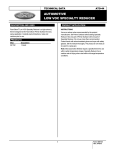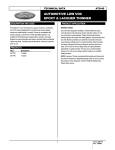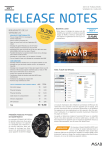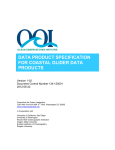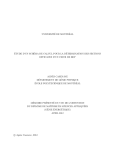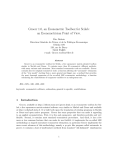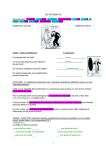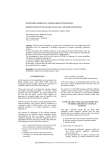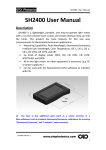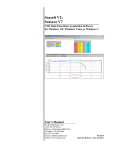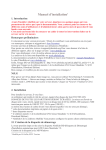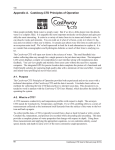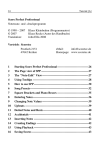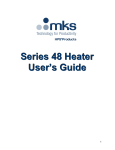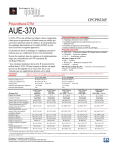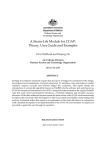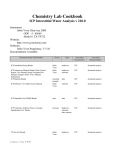Download DATA PRODUCT SPECIFICATION FOR FAST DISSOLVED OXYGEN
Transcript
DATA PRODUCT SPECIFICATION FOR FAST DISSOLVED OXYGEN Version 1-02 Document Control Number 1341-00521 2014-03-06 Consortium for Ocean Leadership th 1201 New York Ave NW, 4 Floor, Washington DC 20005 www.OceanLeadership.org in Cooperation with University of California, San Diego University of Washington Woods Hole Oceanographic Institution Oregon State University Scripps Institution of Oceanography Rutgers University Data Product Specification for Fast Dissolved Oxygen Document Control Sheet Version 0-01 0-02 Date 2012-12-16 2013-02-07 0-03 2013-03-07 1-00 1-01 1-02 2013-03-13 2013-08-29 2014-03-06 Ver 1-02 Description Initial Release Incorporates comments from Focused Review Incorporates comments from Formal Review and adds final test data set to section 4.6 Initial Release Updates to referenced TEOS-10 code Updates to include frequency output 1341-00521 Author M. Vardaro M. Vardaro M. Vardaro E. Griffin M. Vardaro M. Vardaro i Data Product Specification for Fast Dissolved Oxygen Signature Page This document has been reviewed and approved for release to Configuration Management. OOI Senior Systems Engineer: Date:2014-03-07 This document has been reviewed and meets the needs of the OOI Cyberinfrastructure for the purpose of coding and implementation. OOI CI Signing Authority: Date: 2013-03-13 Ver 1-02 1341-00521 ii Data Product Specification for Fast Dissolved Oxygen Table of Contents 1 2 Abstract .........................................................................................................................1 Introduction ....................................................................................................................1 2.1 Author Contact Information ....................................................................................1 2.2 Metadata Information .............................................................................................1 2.3 Instruments ............................................................................................................2 2.4 Literature and Reference Documents ....................................................................2 2.5 Terminology ...........................................................................................................2 3 Theory ...........................................................................................................................4 3.1 Description .............................................................................................................4 3.2 Mathematical Theory .............................................................................................4 3.3 Known Theoretical Limitations ...............................................................................6 3.4 Revision History .....................................................................................................6 4 Implementation ..............................................................................................................6 4.1 Overview ................................................................................................................6 4.2 Inputs .....................................................................................................................6 4.3 Processing Flow.....................................................................................................7 4.4 Outputs ..................................................................................................................8 4.5 Computational and Numerical Considerations ......................................................9 4.6 Code Verification and Test Data Set .....................................................................9 Appendix A Example Code ...........................................................................................1 Appendix B Output Accuracy ........................................................................................1 Appendix C Sensor Calibration Effects .........................................................................1 Ver 1-02 1341-00521 iii Data Product Specification for Fast Dissolved Oxygen 1 Abstract This document describes the computation used to calculate the OOI Level 2 Fast Dissolved Oxygen core data product (DOCONCF), which is calculated using an algorithm based on that of Owens and Millard (1985) that incorporates raw voltage data from the Sea-Bird Electronics SBE 43 and 43F Dissolved Oxygen Sensor (DOFST) family of instruments along with L1 and L2 data products from the conductivity, temperature and depth (CTD) family of instruments. This document is intended to be used by OOI programmers to construct appropriate processes to create the L2 Fast Dissolved Oxygen data product. 2 2.1 Introduction Author Contact Information Please contact Michael Vardaro ([email protected]) or the Data Product Specification lead ([email protected]) for more information concerning the computation and other items in this document. 2.2 Metadata Information 2.2.1 Data Product Name The OOI Core Data Product Name for this product is - DOCONCF The OOI Core Data Product Descriptive Name for this product is - Fast Dissolved Oxygen 2.2.2 Data Product Abstract (for Metadata) The OOI Level 2 Fast Dissolved Oxygen core data product (DOCONCF) is the oxygen concentration (in micromoles per kg, µmol/kg) which is produced using raw voltage data from the Sea-Bird Electronics SBE 43 or frequency data from the 43F Dissolved Oxygen Sensor (DOFST) family of instruments along with L1 and L2 data products from the conductivity, temperature and depth (CTD) instrument to which the SBE 43 is attached. 2.2.3 Computation Name Not required for data products. 2.2.4 Computation Abstract (for Metadata) This computation computes the OOI Level 2 Fast Dissolved Oxygen core data product, which is calculated using an algorithm based on that of Owens and Millard (1985) that incorporates raw voltage data from the Sea-Bird Electronics SBE 43 or frequency data from the 43F Dissolved Oxygen Sensor family of instruments along with L1 Water Temperature (TEMPWAT), L1 Pressure (Depth) Data Product (PRESWAT), L2 Practical Salinity Data Product (PRACSAL) from the conductivity, temperature and depth (CTD) family of instruments, and latitude/longitude from the platform metadata. 2.2.5 Instrument-Specific Metadata See Section 4.4 for instrument-specific metadata fields that must be part of the output data. 2.2.6 Data Product Synonyms Synonyms for this data product are - Oxygen concentration Ver 1-02 1341-00521 Page 1 of 11 Data Product Specification for Fast Dissolved Oxygen 2.2.7 Similar Data Products Similar products that this data product may be confused with are DOCONCS, Stable Dissolved Oxygen, which is derived from the DOSTA Aanderaa Optode family of instruments. Other -1 measurements of oxygen concentration use different units (ml L , % saturation), but the current -1 convention is to use the units described here: micromoles per kg (µmol kg ). 2.3 Instruments For information on the instruments from which the L2 Fast Dissolved Oxygen core data product inputs are obtained, see the DOFST Processing Flow document (DCN 1342-00521). This document contains information on instrument class and make/model; it also describes the flow of data from the DOFST through all of the relevant QC, calibration, and data product computations and procedures. Please see the Instrument Application in the SAF for specifics of instrument locations and platforms. 2.4 Literature and Reference Documents Garcia and Gordon (1992) Oxygen solubility in seawater: Better fitting equations. Limnology & Oceanography. 37(6): 1307-1312. Owens, W.B., and R.C. Millard Jr. (1985) A new algorithm for CTD oxygen calibration. J. Physical Oceanography, 15: 621-631. Pawlowicz, R. (2010). What every oceanographer needs to know about TEOS-10 (The TEOS-10 Primer). Thermodynamic Equation Of Seawater - 2010 (TEOS-10) website: http://www.teos-10.org/ Sea-Bird Electronics, Inc. (2011) SBE 43 User Manual. Bellevue, WA. Sea-Bird Electronics, Inc. (2013) SBE 52-MP Moored Profiler CTD and Optional DO Sensor User’s Manual. Bellevue, WA. Sea-Bird (2009), SBE 16plus V2 SEACAT User’s Manual. Manual Version #005. 2.5 Terminology 2.5.1 Definitions The following terms are defined here for use throughout this document. Definitions of general OOI terminology are contained in the Level 2 Reference Module in the OOI requirements database (DOORS). Potential Density (pot_rho_t) Potential density of seawater, calculated using Absolute salinity, , in situ temperature, sea pressure and a reference pressure (p_ref) of 0 dbar Practical Salinity ( ) Ver 1-02 The measure of salinity defined by the Practical Salinity Scale 1978 (PSS-78). Practical Salinity is a unitless quantity that is approximately equivalent to the mass fraction of dissolved solute in seawater, but is not interchangeable with Absolute Salinity. Practical Salinity is an analogue for conductivity of seawater adjusted for temperature and pressure. 1341-00521 Page 2 of 11 Data Product Specification for Fast Dissolved Oxygen Absolute Salinity ( ): Measure of absolute salinity adopted and defined jointly by the Intergovernmental Oceanographic Commission (IOC), International Association for the Physical Sciences of the Oceans (IAPSO) and the Scientific Committee on Oceanic Research (SCOR) in 2010 as part of the new standard for calculating the thermodynamic properties of seawater. Units of Absolute Salinity -1 are g kg , the mass fraction of dissolved salts in seawater. Absolute Salinity represents, to the best available accuracy, the mass fraction of dissolved solute in a sample of Standard Seawater of the same density as the observed sample (Pawlowicz, 2010). 2.5.2 Acronyms, Abbreviations and Notations General OOI acronyms, abbreviations and notations are contained in the Level 2 Reference Module in the OOI requirements database (DOORS). The following acronyms and abbreviations are defined here for use throughout this document. CTD = Conductivity, Temperature, and Depth instrument SBE 43 = moored mode voltage (V) output SeaBird 43 Dissolved Oxygen Sensor SBE 43F = profiling mode frequency (Hz) output SeaBird 43F Dissolved Oxygen Sensor 2.5.3 Variables and Symbols The following variables and symbols are defined here for use throughout this document. Oxygen T P S V F Soc Voffset Foffset A, B, C E tau20 D1, D2 Oxsol(T,S) δV/δt δF/δt tau(T,P) K pot_rho_t p_ref Ver 1-02 -1 Dissolved oxygen concentration (micromole kg ) CTD Temperature (°C) CTD Pressure (decibars) CTD Salinity (psu) SBE 43 temperature-compensated output oxygen signal (volts) SBE 43F temperature-compensated output oxygen signal (frequency) Oxygen signal slope Voltage at zero oxygen signal Frequency at zero oxygen signal (43F only) Residual temperature correction factors Pressure correction factor Sensor time constant tau (T,P) at 20 ºC, 1 atmosphere, 0 PSU; slope term in calculation of tau(T,P) Temperature and pressure correction factors in calculation of tau(T,P) Oxygen saturation value after Garcia and Gordon (1992) Time derivative of SBE 43 output oxygen signal (volts/second) Time derivative of SBE 43 output oxygen signal (frequency/second) Sensor time constant at temperature and pressure = tau20 * exp (D1 * P + D2 * [T – 20]) Absolute temperature (K = T + 273.15) Potential density of seawater, calculated using Absolute salinity, in situ temperature, and sea pressure Reference pressure, in this case 0 dbar 1341-00521 Page 3 of 11 Data Product Specification for Fast Dissolved Oxygen 3 Theory 3.1 Description Sea-Bird uses an algorithm based on that of Owens and Millard (1985) to convert SBE 43 oxygen sensor voltage data or 43F frequency data to oxygen concentration. The Sea-Bird algorithm incorporates a term related to the offset voltage/frequency produced for zero oxygen signal. In addition, there is a third-order polynomial that compensates for changes in sensitivity with temperature and an exponential term that compensates for changes in sensitivity with pressure. 3.2 Mathematical Theory Sea-Bird’s modified algorithm has the following form (SBE 43 User Manual): (/) = ∗ {( + + (, ) ∗ / )} ∗ "(, ) ∗ (1.0 + & ∗ + ' ∗ ^2 + * ∗ ^3) ∗ ^(((, ∗ )/-)) (the red text (tau and the derivative) indicates that these parameters are removed from the equation if tau is set equal to zero, as recommended by SeaBird) and Oxygen [micromole/Kg] = Oxygen [mL/L] * 44660 [micromole-DO/L] / (pot_rho_t) where: Ver 1-02 1341-00521 Page 4 of 11 Data Product Specification for Fast Dissolved Oxygen Description Computed Input Parameters Calibration Coefficients Symbol Oxygen T P S V F Soc Voffset Foffset A, B, C E tau20 D1, D2 44660 Oxsol(T,S) Calculated Value δV/δt tau(T,P) K pot_rho_t Ver 1-02 Definition Dissolved oxygen concentration (micromole/kg) CTD Temperature (degC) CTD Pressure (dbars) CTD Salinity (psu) SBE 43 temperature-compensated output oxygen signal (volts) SBE 43F temperature-compensated output oxygen signal (frequency) Oxygen signal slope Voltage at zero oxygen signal Frequency at zero oxygen signal (43F only) Residual temperature correction factors Pressure correction factor Sensor time constant tau (T,P) at 20 ºC, 1 atmosphere, 0 PSU; slope term in calculation of tau(T,P) Temperature and pressure correction factors in calculation of tau(T,P) Conversion constant for oxygen (micromole-DO/L) Oxygen saturation value after Garcia and Gordon (1992) Time derivative of SBE 43 output oxygen signal (volts/second) (If tau is set to zero as recommended, the derivative is removed from the equation) Sensor time constant at temperature and pressure = tau20 * exp (D1 * P + D2 * [T – 20]) (This is recommended to be set to zero, which removes the derivative from the equation) Absolute temperature (in Kelvin) Potential density of seawater, calculated using Absolute salinity, in situ temperature, and sea pressure 1341-00521 Page 5 of 11 Data Product Specification for Fast Dissolved Oxygen 3.3 Known Theoretical Limitations The derivative term [tau(T,P) * δV/δt] function is used to improve the response of the measured signal in regions of large oxygen gradients. However, this term also amplifies residual noise in the signal (especially in deep water), and in some situations this negative consequence overshadows the gains in signal responsiveness. It is recommended to set Tau = 0, deleting the entire derivative term from the equation for calculated oxygen. Response time of the SBE 43 and 43F sensor is variable, and temperature dependent. Response time varies from 7 seconds at 29.2 degC to 28 seconds at 1.7 degC. SeaBird recommends a minimum pump time of 15 seconds for 15 degC and warmer water, and reference the 1% curve in the SBE 43 user manual for colder water. 3.4 Revision History No revisions to date. 4 4.1 Implementation Overview The L2 Fast Dissolved Oxygen computation is implemented using a third-order polynomial expression (SBE 43 User Manual), which incorporates raw voltage/frequency data from the SBE 43/43F Dissolved Oxygen Sensor along with L1 Water Temperature (TEMPWAT), L1 Pressure (Depth) Data Product (PRESWAT), L2 Practical Salinity Data Product (PRACSAL) from the CTD to which the DOFST instrument is connected, and latitude/longitude from the platform metadata. This is followed by a subsequent conversion from ml/l units to µmol/kg units. This product is calculated using the potential density, or “pot_rho_t,” so as to correct for compression-related changes in the volume and temperature of the parcel of water being measured. Potential density is different from the OOI L2 DENSITY data product; L2 DENSITY is computed using in situ temperature and pressure, while potential density is calculated using a reference pressure of 0 dbar, in situ temperature, and Absolute Salinity. Timing will be dealt with by interpolating the nearest CTD data to the time of sampling of the oxygen data using the INTERP1 QC algorithm (1341-10002). The oxygen measurement will be delayed until the following CTD measurement. 4.2 Inputs Inputs are: • L0 Fast Dissolved Oxygen measurement [counts, representing volts or frequency], in hex format • Calibration coefficients provided by SeaBird with instrument • DOFST time stamp Inputs from the attached or collocated CTD: • L1 Temperature [degrees C] (see 1341-00010_DPS_TEMPWAT_OOI) • L1 Pressure (sea pressure) [dbar] (see 1341-00020_DPS_PRESWAT_OOI) • L2 Practical Salinity (PSS-78) [unitless] (see 1341-00040_DPS_PRACSAL_OOI) • Latitude and longitude where the input data was collected. This information is the lat/long of the mooring or profiler on which the instrument is fixed and is part of the metadata. • CTD time stamp When available use L1b PRESWAT, L1b TEMPWAT, and L2b PRACSAL data products instead of L1a and L2a data products. Moored Mode Input format: Output from the SeaBird 16plus that will pass through the data from the SBE 43 Dissolved Oxygen sensor is a four-character hex code (vvvv/13,107), as per this example from the SBE Ver 1-02 1341-00521 Page 6 of 11 Data Product Specification for Fast Dissolved Oxygen 16plus Manual (NOTE: in this example the SBE 43 output is the “First external voltage” out of two): example scan = ttttttccccccppppppvvvvvvvvvvvvssssssss = 0A53711BC7220C14C17D82030505940EC4270B • Temperature = tttttt = 0A5371 (676721 decimal); temperature A/D counts = 676721 • Conductivity = 1BC722 (1820450 decimal); conductivity freq. = 1820450 / 256 = 7111.133 Hz • Internally mounted strain gauge pressure = pppppp = 0C14C1 (791745 decimal); Strain gauge pressure A/D counts = 791745 • Internally mounted strain gauge temperature compensation = vvvv = 7D82 (32,130 decimal); Strain gauge temperature = 32,130 / 13,107 = 2.4514 volts • First external voltage = vvvv = 0305 (773 decimal); voltage = 773 / 13,107 = 0.0590 volts • Second external voltage = vvvv = 0594 (1428 decimal); voltage = 1428 / 13,107 = 0.1089 volts • Time = ssssssss = 0EC4270B (247,736,075 decimal); seconds since January 1, 2000 = 247,736,075 Profiling Mode Input Format: Output from the SeaBird 52-MP profiling CTD that will pass through the data from the SBE 43F Dissolved Oxygen sensor is a four-character hex code (oooo), as per this example from the SBE 52 Manual. NOTE: in profiling mode, oxygen data is output as frequency (Hz), and the conversion equation will use “F” and “Foffset” in place of “V” and “Voffset”): Example: example scan = ccccctttttpppppoooo = 5C98D0E2D628E8E3056 • Conductivity = ccccc = 5C98D (379277 decimal); conductivity (mmho/cm) = (379277 / 10,000) – 0.5 = 37.4277 • Temperature = ttttt = 0E2D6 (58070 decimal); temperature (°C, ITS-90) = (58070 / 10,000) – 5 = 0.8070 • Pressure = ppppp = 28E8E (167566 decimal); pressure (decibars) = (167566 / 100) - 10 = 1665.66 • Oxygen = oooo = 3056 (12374 decimal); oxygen (Hz) = 12374 4.3 Processing Flow The specific steps necessary to create all calibrated and quality controlled data products for each OOI core instrument are described in the instrument-specific Processing Flow documents (DCN 1342-XXXXX). These processing flow documents contain flow diagrams detailing all of the specific procedures (data product and QC) necessary to compute all levels of data products from the instrument and the order in which these procedures should be followed. The processing flow for the Fast Dissolved Oxygen computation is as follows (in Matlab syntax): Step 1: Download and convert raw hex code data from SBE 43 to a decimal voltage value and divide by 13107 to produce a floating point number “V” in volts with four decimal places %.4f. If using an SBE 43F in profiling mode, convert the hex code data to a decimal frequency value to produce a floating point number “F” in Hz with two decimal places %.2f. Step 2: Absolute salinity (SA) is calculated from practical salinity (SP, L2 input), sea pressure (p, L1 input), latitude (lat, L1 input metadata) and longitude (long, L1 input metadata) using the function [SA, in_ocean] = gsw_SA_from_SP(SP,p,long,lat) where in_ocean is a flag indicating that the lat/long is well inside the boundaries of dry land. See Appendix A.1 for example code. Ver 1-02 1341-00521 Page 7 of 11 Data Product Specification for Fast Dissolved Oxygen Step 3: Potential density is calculated using a reference pressure of 0 dbar (p_ref = 0), Absolute Salinity (SA, step 1 output), in situ Temperature (t, L1 input) and sea pressure (p, L1 input). pot_rho_t_exact = gsw_pot_rho_t_exact(SA,t,p,p_ref) See Appendix A.2 for example code. Step 4: Oxygen solubility (Oxsol) is calculated by the equations Ts = ln[(298.15– T)/(273.15 + T)] Oxsol(T, S) = exp^{A0 + A1(Ts) + A2(Ts)^2 + A3(Ts)^3 + A4(Ts)^4 + A5(Ts)^5 + [S ∗ (B0 + B1(Ts) + B2(Ts)^2 + B3(Ts)^3)] + C0(S)^2} where Oxsol(T,S) = oxygen saturation value = volume of oxygen gas at standard temperature and pressure conditions (STP) absorbed from humidity-saturated air at a total pressure of one atmosphere, per unit volume of the liquid at the temperature of measurement (ml/l) S = practical salinity (using the L2 PRACSAL data product) o T = in situ water temperature ( C) A0 = 2.00907 A1 = 3.22014 A2 = 4.0501 A3 = 4.94457 A4 = -0.256847 A5 = 3.88767 B0 = -0.00624523 B1 = -0.00737614 B2 = -0.010341 B3 = -0.00817083 C0 = -0.000000488682 Step 5: Fast dissolved oxygen is calculated by the function described in section 3.2 (with the derivative term removed by setting Tau = 0, to prevent amplification of residual noise): (/) = ∗ ( + ) ∗ "(, ) ∗ (1.0 + & ∗ + ' ∗ ^2 + * ∗ ^3) ∗ ^(((, ∗ )/-)) This function is the same for 43F frequency data, but with “F” and “Foffset” in place of “V” and “Voffset”. Step 6: The oxygen concentration is converted from mL/L into micromole/Kg by the function Oxygen[micromole/Kg] = Oxygen[ml/l] ∗ 44660/(pot_rho_t_exact) Step 7: Perform the necessary QC steps as outlined in the processing flow document 4.4 Outputs The outputs of the Fast Dissolved Oxygen computation are Ver 1-02 1341-00521 Page 8 of 11 Data Product Specification for Fast Dissolved Oxygen • -1 Oxygen concentration in µmol kg as a floating point number with two decimal places %.2f. The metadata that must be included with the output are • The source of the PRACSAL, TEMPWAT, and PRESWAT inputs (which should be from the CTD to which the DOFST instrument is attached) • The interpolated PRACSAL, TEMPWAT, and PRESWAT measurements used to perform the calculation • Location (lat/long) • Time See Appendix D for a discussion of the accuracy of the output. 4.5 Computational and Numerical Considerations 4.5.1 Numerical Programming Considerations There are no numerical programming considerations for this computation. No special numerical methods are used. 4.5.2 Computational Requirements L2 PRACSAL, L1 TEMPWAT, and L1 PRESWAT Data Products must be available from the attached CTD instrument, as well as the timestamp information Assuming we are reprocessing the data upon recovery of the various assets, and that one sample is a single data point from any Fast Dissolved Oxygen sensor attached to a profiling CTD, and example number of samples are as follows: • For a deep profiler on RSN or Endurance: 1 sample/second for a 1000m profile with a profiler moving at 0.5 m/s operating 48 times per day (assumes that a CTD profile is taken on both down and up casts and profiler is operating continuously) for 365 days = 7 3.5 *10 samples. 4.6 Code Verification and Test Data Set The code will be verified using the test data set provided, which contains inputs and their associated correct outputs. CI will verify that the code is correct by checking that the output, generated using the test data inputs, is identical to the test data density output. SBE 43 Test Data Set COEFFICIENTS Soc = 0.4396 Voffset = -0.5186 Tau20 = 5.08 A = -3.1867e-003 B = 1.7749e-004 C = -3.5718e-006 E nominal = 0.036 NOMINAL DYNAMIC COEFFICIENTS D1 = 1.92634e-4 D2 = -4.64803e-2 DOFST Voltage Test Data do_raw 0 Ver 1-02 salinity 0.0 temp 0.0 pressure 0.0 lat 50.0 lon 145.0 1341-00521 Intermediate DO (ml/l) -2.332525266 DO (umol/kg) -104.1869283 Page 9 of 11 Data Product Specification for Fast Dissolved Oxygen 6798 16384 32768 65535 0 6798 16384 32768 65535 0 6798 16384 32768 65535 0 6798 16384 32768 65535 0 6798 16384 32768 65535 33.4 31.2 20.1 35.2 35.2 0.0 31.2 20.1 33.4 35.2 0.0 20.1 33.4 31.2 33.4 35.2 31.2 20.1 0.0 33.4 31.2 35.2 20.1 0.0 -30.1 30.3 10.1 20.2 20.2 30.3 -30.1 0.0 10.1 20.2 30.3 10.1 0.0 -30.1 -30.1 20.2 0.0 10.1 30.3 30.3 0.0 -30.1 10.1 20.2 307.5 201.2 5.2 112.1 5.2 307.5 201.2 0.0 112.1 5.2 0.0 112.1 307.5 201.2 112.1 5.2 0.0 201.2 307.5 5.2 0.0 112.1 201.2 307.5 -42.0 39.0 60.0 45.0 60.0 39.0 45.0 50.0 -42.0 50.0 39.0 60.0 45.0 -42.0 60.0 45.0 -42.0 50.0 39.0 60.0 45.0 39.0 -42.0 50.0 -42.0 -70.5 39.0 -125.0 39.0 -70.5 -125.0 145.0 -42.0 145.0 -70.5 39.0 -125.0 -42.0 39.0 -125.0 -42.0 145.0 -70.5 39.0 -125.0 -70.5 -42.0 145.0 0.000797115 1.412078813 5.934280027 10.06589881 -1.149671963 0.000125639 10.82518961 7.744491469 12.49523919 -1.149671963 0.000121139 2.2205184 7.347649726 66.32586768 -7.415682793 0.000120053 2.645019264 6.083964669 10.39697952 -0.966429789 0.000195837 10.2787545 6.083964669 12.68706213 0.03494869 61.89990653 261.0228351 438.6325206 -50.09861089 0.005635974 475.5984302 340.3897211 544.0600381 -50.09857466 0.005434191 97.67068802 319.5738329 2914.002444 -325.155281 0.005231489 115.240647 267.6054819 466.3908327 -42.29682113 0.008532408 449.9501918 267.6060633 567.6400574 SBE 43F Test Data Set COEFFICIENTS Soc = 2.9968e-04 (adj) Foffset = -839.55 Tau20 = 1.72 A = -4.1168e-003 B = 2.4818e-004 C = -3.8820e-006 E nominal = 0.036 NOMINAL DYNAMIC COEFFICIENTS D1 = 1.92634e-4 D2 = -4.64803e-2 Lat = 45 Long = -125 DOFST Frequency Test Data salinity temp pressure 34.1145 15.5257 60.520 34.2845 15.3317 72.580 33.2464 11.9239 31.420 33.5524 12.8940 70.820 Ver 1-02 freq 4354 4143 4583 4476 Intermediate DO (ml/l) 5.89891032167396 5.56780727769487 6.76187243958794 6.458117534861 1341-00521 DO (µmol/kg) 256.974348631580 242.509215041926 294.548757813511 281.302611659343 Page 10 of 11 Data Product Specification for Fast Dissolved Oxygen 33.5619 33.2512 33.2609 33.2716 33.4191 33.2710 33.2808 33.5483 33.5424 33.3458 0.0000 37.7843 35.7594 33.3313 33.3132 33.3132 33.3132 33.3132 33.3132 33.3132 33.3132 Ver 1-02 12.9011 11.9350 11.9715 12.0110 12.4553 11.9932 12.0196 12.8647 12.8448 12.2084 12.0996 10.1230 0.0000 12.0996 12.0996 12.0996 12.0996 12.0996 12.0996 12.0996 12.0996 74.870 29.330 30.950 43.580 65.370 29.460 31.030 74.570 75.070 57.920 42.980 4481 4591 4575 4574 4545 4578 4572 4505 4383 4555 4569 6.46897458201929 6.77275996877815 6.73969994032525 6.74263221709132 6.64102027182035 6.74036293148305 6.72675872808420 6.51674462650798 6.30302843255881 6.68981312176670 8.28303866101280 281.773833754618 295.022573240991 293.582249046689 293.709591753566 289.274637555853 293.610068502014 293.016695107650 283.855524405738 274.546683447082 291.402846954730 370.109515168768 42.980 42.980 0.000 42.980 42.980 42.980 42.980 42.980 42.980 42.980 4023 4569 4569 0 841 1000 2000 4000 5000 6000 10.78098598783980 8.95549253591715 6.68181215593754 -1.51252046989329 0.00261229787546345 0.289064271805584 2.09064901350446 5.69381849690220 7.49540323860107 9.29698798029994 467.353919671818 388.785846175276 291.052144126035 -65.8845095713829 0.113790171971304 12.5914710984794 91.0674517683417 248.019413108066 326.495393777929 404.971374447791 1341-00521 Page 11 of 11 Data Product Specification for Fast Dissolved Oxygen Appendix A A.1 Example Code Absolute Salinity from Practical Salinity USAGE: [SA, in_ocean] = gsw_SA_from_SP(SP,p,long,lat) DESCRIPTION: Calculates absolute salinity from practical salinity. Since SP is nonnegative by definition, this function changes any negative input values of SP to be zero. INPUT: SP p long lat = Practical Salinity (PSS-78) [ unitless ] = sea pressure [ dbar ] ( i.e., absolute pressure - 10.1325 dbar ) = longitude in decimal degrees [ 0 ... +360 ] or [ -180 ... +180 ] = latitude in decimal degrees north [ -90 ... +90 ] p, lat & long may have dimensions 1x1 or Mx1 or 1xN or MxN, where SP is MxN. OUTPUT: SA = Absolute Salinity [g/kg ] in_ocean = 0, if long and lat are a long way from the ocean = 1, if long and lat are in the ocean Note. This flag is only set when the observation is well and truly on dry land; often the warning flag is not set until one is several hundred kilometres inland from the coast. AUTHOR: Trevor McDougall, Paul Barker & David Jackett VERSION NUMBER: 3.0 (23rd May, 2011) REFERENCES: IOC, SCOR and IAPSO, 2010: The international thermodynamic equation of seawater - 2010: Calculation and use of thermodynamic properties. Intergovernmental Oceanographic Commission, Manuals and Guides No. 56, UNESCO (English), 196 pp. Available from the TEOS-10 web site. See section 2.5 and appendices A.4 and A.5 of this TEOS-10 Manual. McDougall, T.J., D.R. Jackett and F.J. Millero, 2010: An algorithm for estimating Absolute Salinity in the global ocean. Submitted to Ocean Science. A preliminary version is available at Ocean Sci. Discuss., 6, 215-242. http://www.ocean-sci-discuss.net/6/215/2009/osd-6-215-2009print.pdf function [SA, in_ocean] = gsw_SA_from_SP(SP,p,long,lat) % gsw_SA_from_SP Absolute Salinity from Practical Salinity %======================================================================== % % USAGE: % [SA, in_ocean] = gsw_SA_from_SP(SP,p,long,lat) % % DESCRIPTION: % Calculates Absolute Salinity from Practical Salinity. Since SP is % non-negative by definition, this function changes any negative input Ver 1-02 1341-00521 Appendix Page A-1 Data Product Specification for Fast Dissolved Oxygen % values of SP to be zero. % % INPUT: % SP = Practical Salinity (PSS-78) [ unitless ] % p = sea pressure [ dbar ] % ( i.e. absolute pressure - 10.1325 dbar ) % long = longitude in decimal degrees [ 0 ... +360 ] % or [ -180 ... +180 ] % lat = latitude in decimal degrees north [ -90 ... +90 ] % % p, lat & long may have dimensions 1x1 or Mx1 or 1xN or MxN, % where SP is MxN. % % OUTPUT: % SA = Absolute Salinity [ g/kg ] % in_ocean = 0, if long and lat are a long way from the ocean % = 1, if long and lat are in the ocean % Note. This flag is only set when the observation is well and truly on % dry land; often the warning flag is not set until one is several % hundred kilometres inland from the coast. % % AUTHOR: % David Jackett, Trevor McDougall & Paul Barker [ [email protected] ] % % VERSION NUMBER: 3.0 (31st May, 2011) % % REFERENCES: % IOC, SCOR and IAPSO, 2010: The international thermodynamic equation of % seawater - 2010: Calculation and use of thermodynamic properties. % Intergovernmental Oceanographic Commission, Manuals and Guides No. 56, % UNESCO (English), 196 pp. Available from http://www.TEOS-10.org % See section 2.5 and appendices A.4 and A.5 of this TEOS-10 Manual. % % McDougall, T.J., D.R. Jackett and F.J. Millero, 2010: An algorithm % for estimating Absolute Salinity in the global ocean. Submitted to % Ocean Science. A preliminary version is available at Ocean Sci. Discuss., % 6, 215-242. % http://www.ocean-sci-discuss.net/6/215/2009/osd-6-215-2009-print.pdf % % The software is available from http://www.TEOS-10.org % %======================================================================== %-------------------------------------------------------------------------% Check variables and resize if necessary %-------------------------------------------------------------------------if ~(nargin==4) error('gsw_SA_from_SP: Requires four inputs') end %if [ms,ns] = size(SP); [mp,np] = size(p); if (mp == 1) & (np == 1) p = p*ones(size(SP)); Ver 1-02 % p is a scalar - fill to size of SP 1341-00521 Appendix Page A-2 Data Product Specification for Fast Dissolved Oxygen elseif (ns == np) & (mp == 1) % p is row vector, p = p(ones(1,ms), :); % copy down each column. elseif (ms == mp) & (np == 1) % p is column vector, p = p(:,ones(1,ns)); % copy across each row. elseif (ns == mp) & (np == 1) % p is a transposed row vector, p = p.'; % transposed then p = p(ones(1,ms), :); % copy down each column. elseif (ms == mp) & (ns == np) % ok else error('gsw_SA_from_SP: Inputs array dimensions arguments do not agree') end %if [mla,nla] = size(lat); if (mla == 1) & (nla == 1) % lat is a scalar - fill to size of SP lat = lat*ones(size(SP)); elseif (ns == nla) & (mla == 1) % lat is a row vector, lat = lat(ones(1,ms), :); % copy down each column. elseif (ms == mla) & (nla == 1) % lat is a column vector, lat = lat(:,ones(1,ns)); % copy across each row. elseif (ns == mla) & (nla == 1) % lat is a transposed row vector, lat = lat.'; % transposed then lat = lat(ones(1,ms), :); % copy down each column. elseif (ms == mla) & (ns == nla) % ok else error('gsw_SA_from_SP: Inputs array dimensions arguments do not agree') end %if [mlo,nlo] = size(long); [Iwest] =find(long < 0); if ~isempty(Iwest) long(Iwest) = long(Iwest) + 360; end if (mlo == 1) & (nlo == 1) % long is a scalar - fill to size of SP long = long*ones(size(SP)); elseif (ns == nlo) & (mlo == 1) % long is a row vector, long = long(ones(1,ms), :); % copy down each column. elseif (ms == mlo) & (nlo == 1) % long is a column vector, long = long(:,ones(1,ns)); % copy across each row. elseif (ns == mlo) & (nlo == 1) % long is a transposed row vector, long = long.'; % transposed then long = long(ones(1,ms), :); % copy down each column. elseif (ms == nlo) & (mlo == 1) % long is a transposed column vector, long = long.'; % transposed then long = long(:,ones(1,ns)); % copy down each column. elseif (ms == mlo) & (ns == nlo) % ok else error('gsw_SA_from_SP: Inputs array dimensions arguments do not agree') end %if if ms == 1 SP = SP.'; Ver 1-02 1341-00521 Appendix Page A-3 Data Product Specification for Fast Dissolved Oxygen p = p.'; lat = lat.'; long = long.'; transposed = 1; else transposed = 0; end [Iout_of_range] = find(p < 100 & SP > 120); SP(Iout_of_range) = NaN; [Iout_of_range] = find(p >= 100 & SP > 42); SP(Iout_of_range) = NaN; [Inan] = find(abs(SP) == 99999 | abs(SP) == 999999); SP(Inan) = NaN; [Inan] = find(abs(p) == 99999 | abs(p) == 999999); p(Inan) = NaN; [Inan] = find(abs(long) == 9999 | abs(long) == 99999); long(Inan) = NaN; [Inan] = find(abs(lat) == 9999 | abs(lat) == 99999); lat(Inan) = NaN; if ~isempty(find(p < -1.5 | p > 12000)) error('gsw_SA_from_SP: pressure is out of range') end if ~isempty(find(long < 0 | long > 360)) error('gsw_SA_from_SP: longitude is out of range') end if ~isempty(find(abs(lat) > 90)) error('gsw_SA_from_SP: latitude is out of range') end %-------------------------------------------------------------------------% Start of the calculation %-------------------------------------------------------------------------% These few lines ensure that SP is non-negative. [I_neg_SP] = find(SP < 0); if ~isempty(I_neg_SP) SP(I_neg_SP) = 0; end [Iocean] = find(~isnan(SP.*p.*lat.*long)); SA = nan(size(SP)); SAAR = nan(size(SP)); in_ocean = nan(size(SP)); % The following function (gsw_SAAR) finds SAAR in the non-Baltic parts of % the world ocean. (Actually, this gsw_SAAR look-up table returns values % of zero in the Baltic Sea since SAAR in the Baltic is a function of SP, % not space. [SAAR(Iocean), in_ocean(Iocean)] = gsw_SAAR(p(Iocean),long(Iocean),lat(Iocean)); SA(Iocean) = (35.16504/35)*SP(Iocean).*(1 + SAAR(Iocean)); Ver 1-02 1341-00521 Appendix Page A-4 Data Product Specification for Fast Dissolved Oxygen % Here the Practical Salinity in the Baltic is used to calculate the % Absolute Salinity there. SA_baltic(Iocean) = gsw_SA_from_SP_Baltic(SP(Iocean),long(Iocean),lat(Iocean)); [Ibaltic] = find(~isnan(SA_baltic(Iocean))); SA(Iocean(Ibaltic)) = SA_baltic(Iocean(Ibaltic)); if transposed SA = SA'; in_ocean = in_ocean'; end end Ver 1-02 1341-00521 Appendix Page A-5 Data Product Specification for Fast Dissolved Oxygen A.2 Potential Density function pot_rho_t_exact = gsw_pot_rho_t_exact(SA,t,p,p_ref) % gsw_pot_rho_t_exact potential density %======================================================================== == % % USAGE: % pot_rho_t_exact = gsw_pot_rho_t_exact(SA,t,p,p_ref) % % DESCRIPTION: % Calculates potential density of seawater. Note. This function outputs % potential density, not potential density anomaly; that is, 1000 kg/m^3 % is not subtracted. % % INPUT: % SA = Absolute Salinity [ g/kg ] [ deg C ] % t = in-situ temperature (ITS-90) % p = sea pressure [ dbar ] % ( i.e. absolute pressure - 10.1325 dbar ) % p_ref = reference pressure [ dbar ] % ( i.e. reference absolute pressure - 10.1325 dbar ) % % SA & t need to have the same dimensions. % p & p_ref may have dimensions 1x1 or Mx1 or 1xN or MxN, where SA & t % are MxN % % OUTPUT: % pot_rho_t_exact = potential density (not potential density anomaly) % [ kg/m^3 ] % % AUTHOR: % David Jackett, Trevor McDougall and Paul Barker [ [email protected] ] % % VERSION NUMBER: 3.02 (15th November, 2012) % % REFERENCES: % IOC, SCOR and IAPSO, 2010: The international thermodynamic equation of % seawater - 2010: Calculation and use of thermodynamic properties. % Intergovernmental Oceanographic Commission, Manuals and Guides No. 56, % UNESCO (English), 196 pp. Available from http://www.TEOS-10.org % See section 3.4 of this TEOS-10 Manual. % % The software is available from http://www.TEOS-10.org % %======================================================================== == %-------------------------------------------------------------------------% Check variables and resize if necessary %-------------------------------------------------------------------------- Ver 1-02 1341-00521 Appendix Page A-6 Data Product Specification for Fast Dissolved Oxygen if ~(nargin == 4 ) error('gsw_pot_rho_t_exact: Requires four inputs') end %if [ms,ns] = size(SA); [mt,nt] = size(t); [mp,np] = size(p); if (mt ~= ms | nt ~= ns) error('gsw_pot_rho_t_exact: SA and t must have same dimensions') end if ~isscalar(unique(p_ref)) error('gsw_pot_rho_t_exact: The reference pressures differ, they should be unique') end if (mp == 1) & (np == 1) % p scalar - fill to size of SA p = p*ones(size(SA)); % p is row vector, elseif (ns == np) & (mp == 1) p = p(ones(1,ms), :); % copy down each column. elseif (ms == mp) & (np == 1) % p is column vector, p = p(:,ones(1,ns)); % copy across each row. elseif (ns == mp) & (np == 1) % p is a transposed row vector, p = p.'; % transposed then p = p(ones(1,ms), :); % copy down each column. elseif (ms == mp) & (ns == np) % ok else error('gsw_pot_rho_t_exact: Inputs array dimensions arguments do not agree') end %if if ms == 1 SA = SA.'; t = t.'; p = p.'; transposed = 1; else transposed = 0; end upr = unique(p_ref); p_ref = upr*ones(size(SA)); %-------------------------------------------------------------------------% Start of the calculation %-------------------------------------------------------------------------pt = gsw_pt_from_t(SA,t,p,p_ref); pot_rho_t_exact = gsw_rho_t_exact(SA,pt,p_ref); if transposed pot_rho_t_exact = pot_rho_t_exact.'; end end Ver 1-02 1341-00521 Appendix Page A-7 Data Product Specification for Fast Dissolved Oxygen A.3 DOCONCF Sample Code function DO = dofst_calc(do_VorF, VorF_offset, Soc, A, B, C, E, T, P, SP, lat, lon) % Description: % Conversion of SBE43 raw measurement(voltage or frequency) to % dissolved oxygen concentration, and applies a potential density % correction from co-located CTD data. OOI L2 data product DOCONCF. % % Usage: % % DO = dostf_calculation(do_VorF,VorF_offset,Soc,A,B,C,E,T,P,SP,lat,lon) % % where % % DO = corrected dissolved oxygen [micro-mole/kg]. % do_VorF = Oxygen sensor voltage or frequency [V] or [Hz]. % VorF_offset = Voltage or Frequency offset [V] or [Hz]. % Soc = Oxygen signal slope % A = Residual temperature correction factor A % B = Residual temperature correction factor B % C = Residual temperature correction factor C % E = Pressure correction factor % T = TEMPWAT water temperature [deg C]. (see % 1341-00010_Data_Product_Spec_TEMPWAT) % P = PRESWAT water pressure [dbar]. (see % 1341-00020_Data_Product_Spec_PRESWAT) % SP = PRACSAL practical salinity [unitless]. (see % 1341-00040_Data_Product_Spec_PRACSAL) % lat, lon = latitude and longitude of the instrument [degrees]. % Author: Mike Vardaro 2013-08-22 % Get the potential density using the TEOS-10 toolbox SA = gsw_SA_from_SP(SP, P, lon, lat); pot_rho_t = gsw_pot_rho_t_exact(SA, T, P, 0); % Oxygen saturation value after Garcia and Gordon (1992) temp_K = T + 273.15; Ts = log((298.15 - T) ./ (temp_K)); % Empirical constants A0 = 2.00907; A1 = 3.22014; A2 = 4.0501; A3 = 4.94457; A4 = -0.256847; A5 = 3.88767; B0 = -0.00624523; B1 = -0.00737614; B2 = -0.010341; B3 = -0.00817083; C0 = -0.000000488682; Oxsol = exp(A0 + A1*Ts + A2*Ts.^2 + A3*Ts.^3 + A4*Ts.^4 + A5*Ts.^5 + ... SP .* (B0 + B1*Ts + B2*Ts.^2 + B3*Ts.^3) + ... Ver 1-02 1341-00521 Appendix Page B-1 Data Product Specification for Fast Dissolved Oxygen C0*SP.^2); % Intermediate step, Dissolved Oxygen concentration in [mL/L] DO_int = Soc * (do_VorF + VorF_offset) .* Oxsol .* ... (1.0 + A*T + B*T.^2 + C*T.^3) .* exp((E * P)./temp_K); % Correct DO_int for Potential Density and convert to [micromole/Kg] DO = DO_int * 44660 ./ (pot_rho_t); Ver 1-02 1341-00521 Appendix Page B-2 Data Product Specification for Fast Dissolved Oxygen Appendix B Output Accuracy The DOCONCF accuracy requirement is stated as: “Upon initial deployment, the instrument shall measure dissolved O2 concentrations with an accuracy within ± 2% of the value provided by a Winkler titration of a corresponding water sample. <L2-SR-RQ-3495, L4-CG-IP-RQ-182, L4-RSN-IP-RQ-312>” This measurement will be performed by the operator and logged with CI prior to deployment. Accuracy of the L2 Fast Dissolved Oxygen data product is dependent on the accuracy of the L1 input to the computation, which for the SBE43 is 2% of saturation. Ver 1-02 1341-00521 Appendix Page B-3 Data Product Specification for Fast Dissolved Oxygen Appendix C Sensor Calibration Effects Not Applicable for Level 2 (L2) data products. Ver 1-02 1341-00521 Appendix Page C-1


























